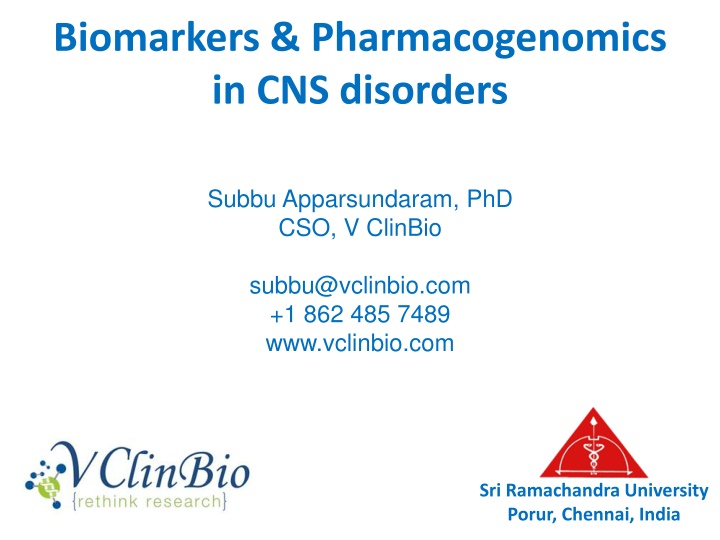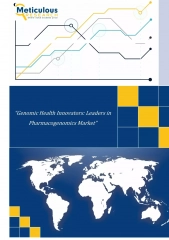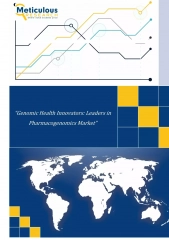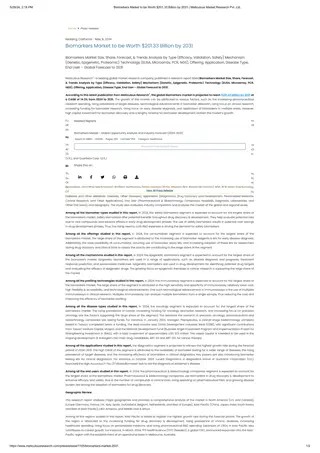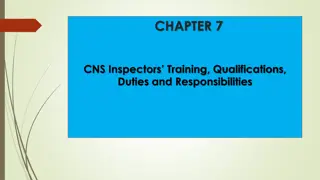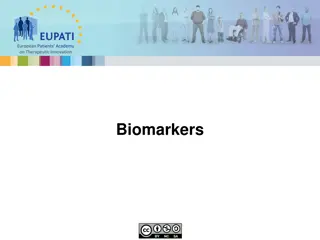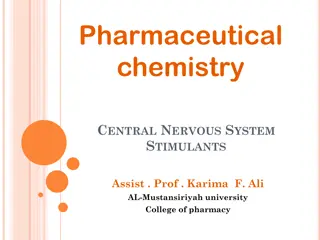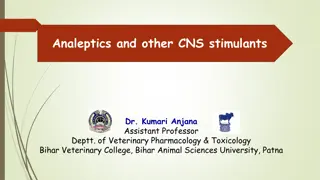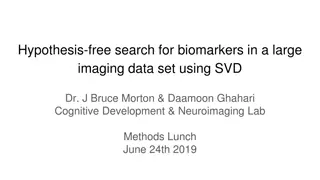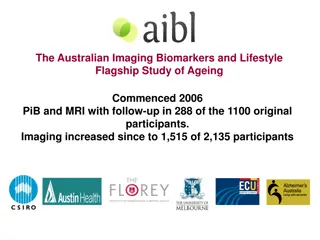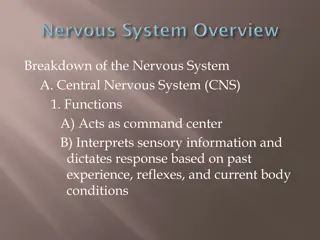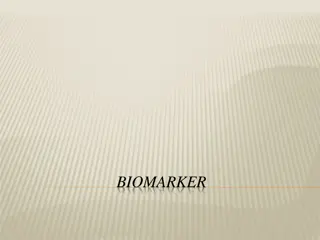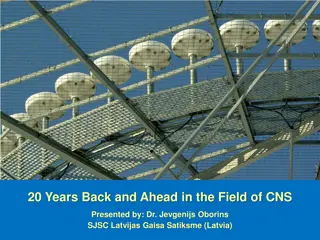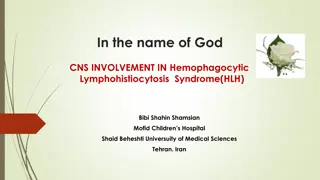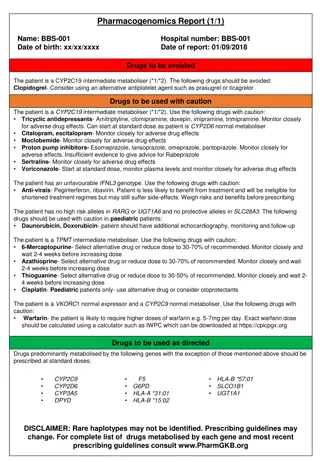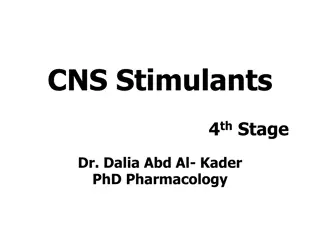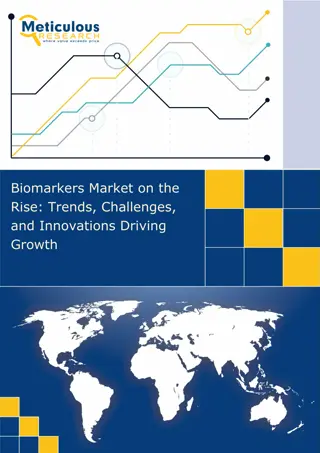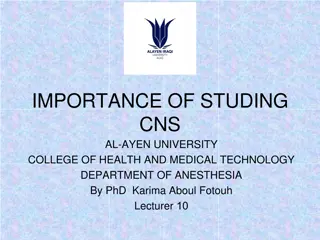Biomarkers & Pharmacogenomics in CNS Disorders
Biomarkers and pharmacogenomics play a crucial role in understanding drug response profiling and the challenges associated with drug therapy in CNS disorders. Multiple factors influence drug response, leading to frustrations for clinicians and patients alike. The FDA has identified pharmacogenomic biomarkers in labeling various oncology drugs to guide treatment decisions. Additionally, other drugs also have pharmacogenomic biomarkers, highlighting the importance of personalized medicine in improving healthcare outcomes.
Download Presentation

Please find below an Image/Link to download the presentation.
The content on the website is provided AS IS for your information and personal use only. It may not be sold, licensed, or shared on other websites without obtaining consent from the author.If you encounter any issues during the download, it is possible that the publisher has removed the file from their server.
You are allowed to download the files provided on this website for personal or commercial use, subject to the condition that they are used lawfully. All files are the property of their respective owners.
The content on the website is provided AS IS for your information and personal use only. It may not be sold, licensed, or shared on other websites without obtaining consent from the author.
E N D
Presentation Transcript
Biomarkers & Pharmacogenomics in CNS disorders Subbu Apparsundaram, PhD CSO, V ClinBio subbu@vclinbio.com +1 862 485 7489 www.vclinbio.com Sri Ramachandra University Porur, Chennai, India
omics based prediction of drug response profiling Meyer et al., Annu. Rev. Pharmacol. Toxicol 53:475-502, 2013
multiple factors influence drug response Meyer et al., Annu. Rev. Pharmacol. Toxicol 53:475-502, 2013
challenges in drug therapy Clinicians frustrations Lack of response Side effects Non-adherence Patient frustrations trial-and-error roller coaster months/years of trying too many side effects multiple medications doctor visits etc missed work
FDA-pharmacogenomic biomarkers in labeling Oncology drugs Ado-Trastuzumab Emtansine Afatinib Anastrozole Arsenic Trioxide Bosutinib Brentuximab Vedotin Busulfan Capecitabine Cetuximab Cetuximab Cisplatin Crizotinib Dabrafenib (1) Dabrafenib (2) Dasatinib Denileukin Diftitox Erlotinib (1) Erlotinib (2) Erlotinib (1) Erlotinib (2) Everolimus (1) Everolimus (2) Exemestane Fluorouracil (2) Fulvestrant Ibritumomab Tiuxetan Imatinib (1) Imatinib (2) Imatinib (3) Imatinib (4) FIP1L1/PDGFRA Irinotecan UGT1A1 Lapatinib ERBB2 Letrozole ESR1, PGR Mercaptopurine Nilotinib (1) BCR/ABL1 Nilotinib (2) UGT1A1 Obinutuzumab Ofatumumab Omacetaxine Panitumumab (1) Panitumumab (2) Pazopanib UGT1A1 Pertuzumab ERBB2 Ponatinib BCR ABL T315I DPYD ESR1 MS4A1 KIT BCR/ABL1 PDGFRB Rituximab MS4A1 Tamoxifen (1) Tamoxifen (2) Tamoxifen (3) Thioguanine Ticagrelor Tositumomab Trametinib Trastuzumab Tretinoin ERBB2 EGFR ESR1, PGR PML/RARA BCR/ABL1 ESR1, PGR F5 F2 TPMT CYP2C19 MS4A1 BRAF ERBB2 PML/RARA TNFRSF8 Ph Chromosome DPYD EGFR KRAS TPMT ALK BRAF G6PD BCR/ABL1 IL2RA EGFR EGFR EGFR EGFR ERBB2 ESR1 ESR1 TPMT MS4A1 MS4A1 BCR/ABL1 EGFR KRAS
FDA-pharmacogenomic biomarkers in labeling other drugs Drug Symbol Abacavir Atorvastatin Azathioprine Boceprevir Carglumic Acid Carisoprodol Carvedilol Celecoxib Cevimeline Chloroquine Chlorpropamide Clopidogrel Dapsone Dapsone Dexlansoprazole Dexlansoprazole Eltrombopag Eltrombopag Esomeprazole Fluorouracil Flurbiprofen Glimepiride Glipizide Glyburide Therapeutic Area HUGO Ivacaftor Lansoprazole Lenalidomide Lomitapide Mafenide Maraviroc Methylene Blue Metoclopramide Metoprolol Mipomersen Mycophenolic Acid Nalidixic Acid Nitrofurantoin Omeprazole Pantoprazole Peginterferon alfa-2b Pegloticase Perphenazine Phenytoin Prasugrel Pravastatin Primaquine Propafenone Propranolol Quinidine Pulmonary Gastroenterology Hematology del ( Endocrinology Infectious Diseases Infectious Diseases Hematology G6PD Gastroentrology Cardiology CYP2D6 Endocrinology Transplantation Infectious Diseases Infectious Diseases Gastroenterology Gastroenterology Infectious Diseases Rheumatology Psychiatry CYP2D6 Neurology HLA-B Cardiology CYP2C19 Endocrinology Infectious Diseases Cardiology CYP2D6 Cardiology CYP2D6 Cardiology CYP2D6 CFTR CYP2C19 5q) LDLR G6PD CCR5 Infectious Diseases Endocrinology Rheumatology Infectious Diseases Metabolic Disorders Rheumatology Cardiology Rheumatology Dental Infectious Diseases Endocrinology Cardiology Dermatology Infectious Diseases Gastroenterology Gastroenterology Hematology Hematology Gastroenterology Dermatology Rheumatology Endocrinology Endocrinology Endocrinology HLA-B LDLR TPMT IFNL3 NAGS CYP2C19 CYP2D6 CYP2C9 CYP2D6 G6PD G6PD CYP2C19 G6PD G6PD CYP2C19 CYP1A2 F5 SERPINC1 CYP2C19 DPYD CYP2C9 G6PD G6PD G6PD CYB5R1-4 LDLR HPRT1 G6PD G6PD CYP2C19 CYP2C19 IFNL3 G6PD LDLR G6PD
FDA-pharmacogenomic biomarkers in labeling other drugs Drug Quinidine Quinine Sulfate Rabeprazole Rifampin, Rosuvastatin Simeprevir Sodium Nitrite Sofosbuvir Succimer Sulfamethoxazole and Trimethoprim Telaprevir Terbinafine Ticagrelor Tolterodine Voriconazole Warfarin (1) Warfarin (2) Cardiology or Hematology Warfarin (3) Cardiology or Hematology Therapeutic Area HUGO Symbol Cardiology Infectious Diseases Gastroenterology Infectious Diseases Endocrinology Infectious Diseases Antidotal Therapy Infectious Diseases Hematology CYP2D6 G6PD CYP2C19 NAT1-2 LDLR IFNL3 G6PD IFNL3 G6PD Infectious Diseases Infectious Diseases Infectious Diseases Cardiology Genitourinary Infectious Diseases Cardiology or Hematology G6PD IFNL3 CYP2D6 CYP2C19 CYP2D6 CYP2C19 CYP2C9 VKORC1 PROC PharmGKB: http://www.pharmgkb.org
FDA CNS Drugs: pharmacogenomic biomarkers in labeling CYP2D6 CYP2C19 Citalopram Clobazam Drospirenone Ethinyl Estradiol HLA-B Amitriptyline Aripiprazole Atomoxetine Citalopram Clomipramine Clozapine Codeine Desipramine Dextromethorphan & Quinidine Diazepam Doxepin Fluoxetine Fluvoxamine Iloperidone Imipramine Modafinil Nortriptyline Paroxetine Perphenazine Pimozide Protriptyline Risperidone Tetrabenazine Thioridazine Phenytoin HLA-A HLA-B Carbamazepine
cytochrome P450 enzymes (CYPs) # of SNPs per CYP # drugs metabolized per CYP CYP2C19 CYP2D6 Preissner et al. 2013 PLOS one : e 8562
Tricyclic antidepressant metabolism by CYP2D6 and CYP2C19 Clinical Pharmacology & Therapeutics 93: 402-408, 2013 Parent drug CYP2C19 metabolite CYP2D6 metabolite Therapeutic drug monitoring Amitriptyline Nortriptyline hydroxy-amitriptyline amitriptyline + nortriptyline desmethyl- clomipramine clomipramine + desmethyl- clomipramine Clomipramine hydroxy-clomipramine Desipramine -------- hydroxy-desipramine desipramine Doxepin desmethyl-doxepin hydroxy-doxepin doxepin + desmethyl-doxepin imipramine + desmethyl- imipramine Imipramine Desipramine hydroxy-imipramine Nortriptyline -------- hydroxy-nortriptyline nortriptyline desmethyl- trimipramine trimipramine + desmethyl- trimipramine Trimipramine hydroxy-trimipramine
association between allelic variants & enzyme activity CYP2D6 Functional Status Functional / normal activity / wild-type Reduced function / decreased activity Activity Value Alleles *1, *2, *27, *33, *35, *45, *46, *39, *48, *53 *9, *10, *17, *29, *41, *49, *50, *54, *55, *59, *69, *72 *3, *4, *5, *6, *7, *8, *11, *12, *13, *14, *15, *16, *18, *19, *20, *21, *31, *36, *38, *40, *42, *44, *47, *51, *56, *57, *62 1 0.5 Non-functional / no activity 0 Functional Status Alleles Functional / normal activity / wild-type *1 CYP2C19 Loss-of-function / no or decreased activity *2, *3, *4, *5, *6, *7, *8 Gain-of-function / increased activity *17 Clinical Pharmacology & Therapeutics 93: 402-408, 2013
CYP2D6 genotypes with resulting activity scores and phenotype classification CYP2D6 Activity Score 3.0 2.5 2.0 1.5 1.0 1.0 1.0 0.5 0 CYP2D6 Diplotype Allele 1 Allele 2 Phenotype *1 *2x2 *1 *1 *2 *1 *10 *4 *5 *1xN *41 *2 *17 *3 *4x2 *10 *10 *6 *1/*1xN *2x2/*41 *1/*2 *1/*17 *2/*3 *1/*4x2 *10/*10 *4/*10 *5/*6 UM UM EM EM EM EM EM IM PM EM = extensive metabolizer; PM = poor metabolizer IM = intermediate metabolizer; UM = ultrarapid metabolizer Clinical Pharmacology & Therapeutics 93: 402-408, 2013
predicted metabolizer phenotypes based on CYP2D6 diplotypes Predicted Metabolizer Phenotype (Range Multi-Ethnic Frequencya) *1xN or *2xN EM UM EM EM EM UM EM EM *4 or *4xN Allele *1 *2 *3 *5 *6 *9 *10 *17 *41 *1 *2 EM EM EM EM EM EM EM EM EM EM EM EM EM *1xN or *2xN *3 *4 *5 *6 *9 *10 *17 *41 EM or UM EM or UM EM or UM EM or UM UM UM UM UM UM PM PM PM PM PM PM PM PM PM PM IM IM IM IM EM IM IM IM IM EM EM IM IM IM IM EM EM EM IM IM IM IM EM EM EM EM Clinical Pharmacology & Therapeutics 93: 402-408, 2013
predicted metabolizer phenotypes based on CYP2C19 diplotypes Predicted Metabolizer Phenotype (Range Multi-Ethnic Frequencya) Allele *1 *2 *3 *4 *5 *6 *7 *8 *17 *1 *2 *3 *4 *5 *6 *7 *8 *17 EM IM IM IM IM IM IM IM UM PM PM PM PM PM PM PM PM PM PM PM PM PM PM PM PM PM PM PM PM PM PM PM PM PM PM PM PM IM IM IM IM IM IM IM UM Clinical Pharmacology & Therapeutics 93: 402-408, 2013
frequenciesof CYP2C19 alleles in major race/ethnic groups Middle Eastern 0.87 0.12 0.011 ND ND ND ND ND South/Cent ral Asian 0.62 0.35 0.024 0.00 0.00 0.00 ND ND C African American East Asian European Oceanian *1c *2 *3 *4 *5 *6 *8 *17 0.68 0.15 0.0052 0.00093 ND 0.00 0.00 0.16 0.69 0.12 0.00028 0.0024 0.00 0.00 0.0012 0.18 0.60 0.29 0.089 0.00049 0.00062 0.00 0.00 0.027 0.63 0.15 0.0042 0.0025 0.000073 0.00017 0.0035 0.21 0.24 0.61 0.15 ND ND ND ND ND Clinical Pharmacology & Therapeutics 93: 402-408, 2013
other pathways modulating antidepressant action Norepinephrine COMT MAO-A SLCA2 5-HT SLC6A4 HTR1A HTR1B HTR2A HTR3A HTR3B HTR6 HPA axis FKBP5 NR3C1 Signal transduction & growth factors BDNF GNB3 OPRM1 dopamine SL6A3 DRD4 enzymes ACE GSK3B IDO2 glutamatergic GR1K4 TPH1 TPH2
antidepressant treatment algorithms Assurex GeneSight
clinical implications Patient stratification procedures in clinical practice will be useful to achieve greater efficacy and safety Genotyping (stratification) prior to treatment may provide tailored therapies Regional differences in genotypes (stratification) should be investigated to facilitate dosing and regimen
Omic technologies can be applied in different phases of drug discovery and development Patient stratification Efficacy & Safety readouts Sri Ramachandra University Chennai, India
frequenciesof CYP2D6 alleles in major race/ethnic groups Caucasian (European + North American) South/ Central Asian African American Middle Eastern Allele African East Asian Americas Oceanian *1c 0.39 0.41 0.52 0.59 0.34 0.53 0.62 0.70 *2d 0.20 0.12 0.27 0.24 0.12 0.31 0.24 0.012 *3 0.0003 0.0034 0.013 0.0013 0.00 0.00 0.0052 0.00 *4 0.033 0.06 0.18 0.076 0.0045 0.065 0.11 0.011 *5 0.06 0.058 0.028 0.023 0.058 0.025 0.016 0.049 *6 0.00 0.0027 0.0091 0.0096 0.0002 0.00 0.005 0.00 *7 0.00 0.00 0.0012 0.00 0.00 ND 0.00 0.00 *8 0.00 0.00 0.0003 0.00 0.00 ND 0.0015 0.00 *9 0.0010 0.0054 0.02 0.00 0.0008 0.014 0.013 0.00 *10e 0.067 0.043 0.028 0.035 0.42 0.19 0.034 0.016 *14 0.0013 0.00 0.00 0.00 0.0092 0.00 0.0047 0.00 *17f 0.19 0.18 0.0027 0.014 0.0002 0.0038 0.023 0.0005 *36 0.00 0.0056 0.00 0.00 0.017 ND ND 0.00 *41g 0.10 0.10 0.092 0.22 0.022 0.10 0.057 0.00 xNh 0.075 0.043 0.028 0.067 0.015 0.013 0.033 0.088 *1xNi 0.014 0.0044 0.0077 0.038 0.0031 0.0050 0.0078 0.11 *2xNi 0.015 0.016 0.013 0.036 0.0042 0.0050 0.023 0.00 *4xNi 0.014 0.020 0.0028 0.00 0.00 0.00 0.0036 0.00 Clinical Pharmacology & Therapeutics 93: 402-408, 2013
challenges in antidepressant therapy Lack of response: ~ 50% of patients with depression do not respond to their first treatment Side effects: In the clinical studies, up to 30% of patients discontinues treatment due to intolerable side effects Nonadherance: Up to 7% of patients receiving prescription for antidepressant drugs are non-adherent, with side effects most common reason Patient frustrations trial-and-error roller coaster months/years of trying too many side effects multiple medications doctor visits etc one size fits all
Supplemental Table S4.Association between allelic variantsa and CYP2D6 enzyme activity Functional Status Alleles References Functional / normal activity / wild-typea 57 *1 58-64 Loss-of-function / no or decreased activity *2, *3, *4, *5, *6, *7, *8 65-67 Gain-of-function / increased activity *17
Tricyclic antidepressant metabolism by CYP2D6 and CYP2C19 Clinical Pharmacology & Therapeutics 93: 402-408, 2013
Tricyclic antidepressant metabolism by CYP2D6 and CYP2C19 Clinical Pharmacology & Therapeutics 93: 402-408, 2013
pharmacogenomics: phenytoin Clinical Pharmacology & Therapeutics 93: 402-408, 2013
